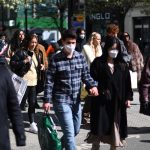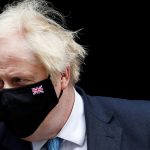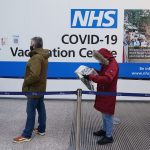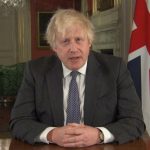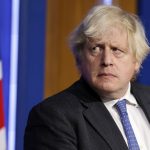Relief, excitement, nervousness, anxiety; just some of the sentiments expressed by pupils and teachers at St Francis’ Catholic Primary School in east London on Monday, as children went back to school after nine weeks of lockdown.
But it wasn’t just a big moment for those children, teachers and parents, it is a big moment for the whole of England.
The ‘big bang’ reopening of schools in England the first staging post on our way out of the third lockdown, towards near-normal life by 21 June.
From the classrooms across England to the government’s headquarters in Downing Street, the emotions are much the same.
Please use Chrome browser for a more accessible video player
On the heels of the dreadful winter and appallingly high death toll, there is palpable relief and excitement that the successful vaccine rollout is improving the outlook not just for the economy – official budget forecasts revised upwards as the number of people receiving their first jab passed 20 million – but of the government too.
A YouGov survey last week gave the Conservatives a 13-point lead over Labour (more on how much this will be dented about the blazing row over nurses pay later) as Rishi Sunak’s budget polled as the most popular in a decade, with 55% of those polled describing it as fair.
The prime minister’s personal ratings are improving. It all points to a good show for Boris Johnson’s Conservatives in the May local elections.
“The mood is chippier,” says one senior Conservative minister. “We’ve weathered the storm.”
But there is plenty of nervousness, too. The ‘big bang’ approach in England, in contrast to Scotland and Wales’s staggered approach, is jangling nerves.
Everyone agrees the return of millions of children back to school will see infection rates increase, which is why the government is keeping the rest of the country locked down until after the Easter break.
What is driving the decisions in No 10 is the determination that the promised “one-way exit” from the third lockdown will be delivered. Boris Johnson, who in the first year of this pandemic over-promised only to disappoint, has ditched his trademark ‘boosterism’ and is instead now the cautious optimist.
But there remains a big question mark still over whether the prime minister might be tempted to accelerate his carefully crafted unlocking plan as the vaccine programme outpaces expectations and data on infection rates, hospitalisations and deaths continue to move in the right direction.
“I do think in five weeks’ time, when another, say, 18 million people have been vaccinated, the narrative could start to shift,” says one senior government figure, who predicts the political pressure on the prime minister will build.
“Once we’re through Easter, some might want to assess the rules generally from across government, so it’s not impossible [the timetable might be accelerated],” says another senior source. “But once we get to May it moves quite quickly anyway.”
And here comes the trepidation. Managing the journey out of lockdown, the cabinet and the party is of course a hefty short-term pressure on the prime minister. But even if the timing and staging is successful, the vaccination programme doesn’t guarantee that we will reach the destination of sunny uplands.
There will continue to be outbreaks and another spike in the virus as society reopens. Not everyone will be vaccinated and there will be difficult questions to tackle around lower take-up of the vaccine in some ethnic minority groups; whether to give the vaccine to children (to protect others rather than themselves).
Dr Sarah Hopkins, Public Health England’s strategic response director, told the BBC’s Andrew Marr Show that the autumn could be challenging because of new virus strains, while warning we “have to prepare for a hard winter” given the risk for surges in respiratory viruses – for example, because COVID measures (social distancing, hand washing, lockdowns) will leave more people vulnerable to other illnesses.
And what of anxiety? While the budget last week was well-received, the economic shock of COVID is both stark and enduring and the continued fallout as uncertain: the economic forecasts upon which the chancellor made his tax and spend decisions last week are very unlikely to stand the test of time.
The path of this virus and shape of the recovery is still too unpredictable. COVID is expected to leave a permanent scar on the economy (with economic output forecast to be 3% below its pre-virus path).
Please use Chrome browser for a more accessible video player
What this government needs is economic growth and the chancellor is hoping that his £27bn super deduction tax scheme – a tax break for companies investing in plants and machinery – will bring forward investment to kick start the economy in the next couple of years.
But no-one can really know if it will be enough, and in the meantime, the government is bracing for a difficult winter economically as the government furlough and self-employed support schemes unwind and unemployment hits.
And what about government spending? Mr Sunak’s desire to bind together a promise of being the party of public services with fiscal discipline is a very difficult tightrope to walk.
Planned spending cuts in unprotected departments – he pencilled in another £4bn of cuts from day-to-day public spending after 2021-2022 on top of the £12bn announced in the Spending Review last year – is going to really bite as a decade of austerity collides with the long-tail of the COVID crisis.
Economists last week concluded that Mr Sunak’s spending plans did not factor in the post-pandemic costs of COVID for the health service, schools, local government, welfare, the courts.
Mr Sunak has signalled tax rises too to try to get the public finances onto a sustainable footing but the black hole on the public finances – at £27bn in November – is now in the low £30bns, and it could get bigger still. The spending review later this year – which could come in July or in the autumn – and the autumn statement is set to be a much more difficult affair than last week’s budget.
Please use Chrome browser for a more accessible video player
The row this week over NHS pay is a taster of the tension for a chancellor who wants the Conservatives to be the ‘party of public finances’ while also repairing the public finances: The chancellor’s view is to be unrelenting on public sector pay against the backdrop of growing unemployment.
Mr Sunak, along with his deputy Steve Barclay, believes that private sector wages have taken a kicking over the crisis and restraining public sector pay is an issue of fairness.
But the optics of refusing NHS workers an extra £500m-a-year pay rise in the context of spending £400bn on COVID support over the past year, seems mean spirited to many.
“Rishi is careful with the pennies and careless with the pounds,” is how one colleague wryly puts it. Another sees it as an own goal that will need to be reversed. “It’s about the overpowering optics and what it says about you as a party.”
There are heavy hints swirling in Westminster that the pay review body will come back with a higher figure and that the settlement will be higher. “This is the start of a negotiation”.
Please use Chrome browser for a more accessible video player
There will be pressure too to pump more money into schools as teachers grapple with the fallout of children missing an average 109 teaching days out of 195. A huge amount of school missed and a huge bridge to gap for many children, academically and emotionally too.
For now, the focus is on lifting the lockdown in an irreversible way. Ministers are determined schools will not close again, even as they brace for an imminent surge in cases on the back of schools returning.
What that means for the prime minister’s timeline for lifting the lockdown remains to be seen. But what is coming into view is the sheer scale of the longer term economic and educational repair job that comes next.


